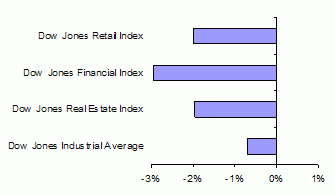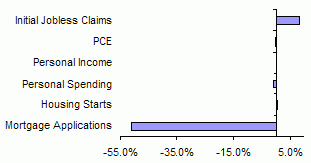Bearish outlook for the US consumer remains one of the driving forces behind a similarly pessimistic view for the domestic economy. Given worsening trends in labor data and uninspiring Retail Sales results, it remains clear that momentum remains to the downside for relevant consumer activity indicators. Such developments may be singlehandedly sufficient in justifying further Federal Reserve interest rate cuts, and indeed markets have clearly discounted aggressive rate reductions. Whether or not the Fed actually follows through with market predictions will very much depend on medium term developments in domestic labor and consumer spending trends.
CREDIT MARKET: HOW IS IT DOING
Conditions in the credit market worsened over the past week with the cost of protecting corporate bonds from default soared to a record. Adding fuel to the already turbulent market were a few major news headlines that threaten to further disrupt the much needed rebound in confidence among lenders and borrowers. From the UK, news that the government would nationalize troubled bank Northern Rock, until a fair sale went through, calmed fears of an impending bankruptcy. However, it would also signal to the market that the government was more concerned about the state of the financial markets than they had originally let on. The other headline that played on the market was news that some of the largest bond insurers would divest their subprime branches to protect their credit rating. This would leave $580 billion in assets open to downgrades. A DEEPER LOOK INTO THE CHANGES THIS WEEK:
A DEEPER LOOK INTO THE CHANGES THIS WEEK:
Falling interest rates have done little to stimulate growth or to improve sentiment in the lending market. Credit default swaps rose to a record high Wednesday as testimony from Fed Chairman Bernanke and Treasury Secretary Paulson last week rung in investors' ears. With the Fed expecting worsening conditions in lending and growth, demand for credit will struggle. Short-term money market assets struggled through another week of falling rates. Demand at the short-end of the yield curve persisted thanks to demand from lenders looking to cover their long-term liabilities with short-term debt. With rates LIBOR rates testing new, multi-year lows, it is clear the market is calling on the Fed for another aggressive rate cut in March.
Short-term money market assets struggled through another week of falling rates. Demand at the short-end of the yield curve persisted thanks to demand from lenders looking to cover their long-term liabilities with short-term debt. With rates LIBOR rates testing new, multi-year lows, it is clear the market is calling on the Fed for another aggressive rate cut in March.
STOCK MARKET: HOW IS IT DOING?
The bullish rebound in stocks last week proved to be short-lived. Bears retook the controls on the equities market, guiding the benchmark Dow Jones Industrial average back below 12,300 in a 2.5 percent pull back from last week's highs. Technically, the benchmark stock indexes have entered a period of congestion that are now producing notable wedges which may call for resolution on direction sooner rather than latter. From the headlines, there have been few encouraging reports for equity investors to cling to. Bernanke and Paulson's testimony before congress last week produced forecasts for troubles in lending and the housing market to deepen before they improve. Further promoting selling sentiment, consumer confidence dropped to a 16-year low while core inflation grew at its fastest clip in 11 months. With conditions clearly souring for the economy's largest sector, the outlook for revenue does not look promising. A DEEPER LOOK INTO THE CHANGES THIS WEEK:
A DEEPER LOOK INTO THE CHANGES THIS WEEK:
Breaking the Dow down, there were few sectors that were bucking the market's bearish momentum. However, there were a few standout underperformers in the mix. This past week's consumer-centric data hit the retail sector disproportionately as vital domestic consumption threatens to plunge faster than the rebound in foreign orders can fill in. The other, hard hit sector was the Financial group. A few, new writedowns from major banks suggests there is still a considerable pool of assets out there that have yet to be assigned a market-calculated value. Though the broad market as rather reserved in its weekly decent, the financial sector was looking at substantial losses. The top fundamental headline for group were reports that major bond insurers would split, leaving the credit rating on their core business safe and allowing the subprime and hard hit ABS groups to fend for themselves. While this would salvage the overall firm's credit rating, it would also almost certainly lead to significant downgrades on $580 billion in assets and further roil the credit markets.
Though the broad market as rather reserved in its weekly decent, the financial sector was looking at substantial losses. The top fundamental headline for group were reports that major bond insurers would split, leaving the credit rating on their core business safe and allowing the subprime and hard hit ABS groups to fend for themselves. While this would salvage the overall firm's credit rating, it would also almost certainly lead to significant downgrades on $580 billion in assets and further roil the credit markets. U.S. CONSUMER: HOW ARE THEY DOING?
U.S. CONSUMER: HOW ARE THEY DOING?
Bearish outlook for the US consumer remains one of the driving forces behind a similarly pessimistic view for the domestic economy. Given worsening trends in labor data and uninspiring Retail Sales results, it remains clear that momentum remains to the downside for relevant consumer activity indicators. Such developments may be singlehandedly sufficient in justifying further Federal Reserve interest rate cuts, and indeed markets have clearly discounted aggressive rate reductions. Whether or not the Fed actually follows through with market predictions will very much depend on medium term developments in domestic labor and consumer spending trends. A DEEPER LOOK INTO THE CHANGES THIS WEEK:
A DEEPER LOOK INTO THE CHANGES THIS WEEK:
MBA Mortgage Applications continued their incredible volatility through recent weeks, falling an incredible 22.6 percent in the seven days ending February 15. Such week-to-week jumps arguably underline the stresses in the domestic mortgage market, and the elevated levels of MBA Mortgage Applications highlight difficulty in obtaining credit. Recent housing market indicators have remained relatively stable, but risks continue to remain for a persistent US housing recession. Outlook for the domestic homeowner looks dim in the absence of a clear improvement in US real estate trends. Walmart shares continue to outperform broader equity markets, and recently bullish earnings data suggests that the discount retailer may be able to withstand bearish momentum for the retail sector. Home improvement company Home Depot has not been nearly as fortunate, and persistent pessimism on domestic housing trends may potentially force further losses in the company's shares. Seen through relevant stock indices, markets remain bearish on prospects for the domestic consumer.
Walmart shares continue to outperform broader equity markets, and recently bullish earnings data suggests that the discount retailer may be able to withstand bearish momentum for the retail sector. Home improvement company Home Depot has not been nearly as fortunate, and persistent pessimism on domestic housing trends may potentially force further losses in the company's shares. Seen through relevant stock indices, markets remain bearish on prospects for the domestic consumer.
DailyFX
skip to main |
skip to sidebar
Search
Categories
- Forex (176)
- Economy (96)
- Finance and Investment (86)
- Business Opportunities (59)
- Forex Education (13)
- World News (10)
- Insurance (9)
- Forex News (6)
- Mortgage (5)
- Real Estate (4)
Popular Posts
-
(Week of 25 February to 2 March 2008) - Both the February German ifo business climate and the March GfK German consumer confidence are expec...
-
(Week of 25 February to 2 March 2008) - Producer price inflation could have accelerated in January - Consumer confidence indicators are like...
Recommended
Copyright © 2008 Money Making Lounge





 2/20/2008
2/20/2008

 Posted in:
Posted in:
0 comments (click to leave a comment):
Post a Comment